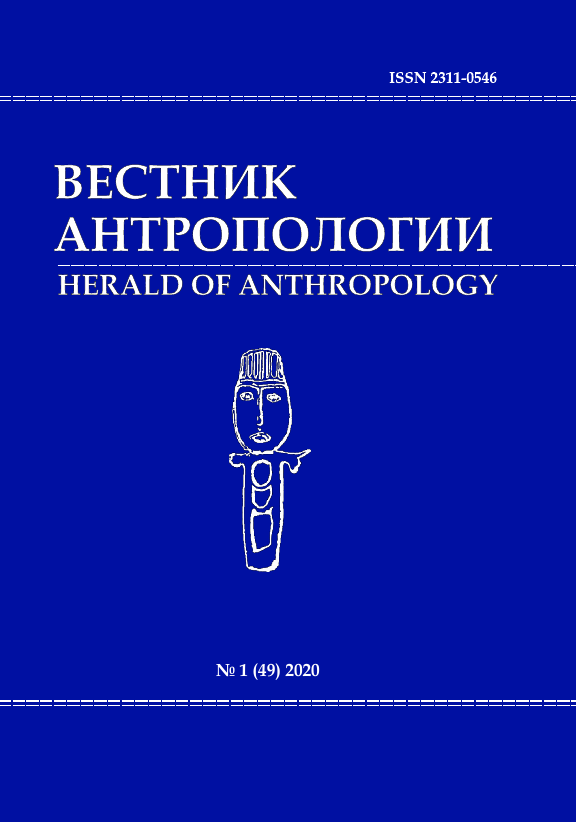Pilot Research on Anatomical Variants of Branches of Diploic Channels of the Cranial Vault
DOI: 10.33876/2311-0546/2020-49-1/78-85
Keywords:
diploic channels, variants of the ramification, variability, computed tomography, research methods, visualization, RadiAnt softwareAbstract
The research tested a method of visualization of diploic channels. The 3D meshes were built based on the CT scans of four skulls. The materials used in this study are stored at the Department of Human Anatomy of the Medical Institute of the Penza State University. The RadiAnt software was used for visualization, which allowed to reconstruct the shape of internal cavities in the diploe layer, including the pattern of the diploic channels. The research revealed the great variability of branching of the diploic channels in every skull. In addition, branching of the diploic channels is found to be very heterogeneous as seen along the CT slices. The proposed research method proved effective to determine the position of anastomoses in the frontal, temporal and occipital channels. Branches of the longitudinal emissaries extending to the anterior sections of the parietal region channel are visible on all CT images. In general, the use of the proposed method of visualization of diploic channels is thought to be prospective.
References
- Zaychenko, A.I. 1971. Kanaly diploicheskikh ven i klassifikatsionnyye kriterii ikh izucheniya [Channels of diploe veins and classification criteria for studying them]. In Materialy nauchnoy konferentsii, posvyashchennoy stoletiyu so dnya rozhdeniya V.N. Tonkova, 150. Leningrad: Izdatel’stvo VMA.
- Zaychenko, A.A. 2015. Sravnitel'noye topograficheskoye issledovaniye kanalov bokovoy linii i diploicheskikh kanalov [Comparative topographic study of the lateral line canals and diploic channels]. In Nauchnaya internet-konferentsiya «Sovremennyye aspekty makro- i mikromorfologii». 5(7):1026-1029.
- Kalmina, O.A., O.V. Kalmin, D.S. Ikonnikov. 2018. Sledy patologicheskikh izmeneniy na cherepakh naseleniya Penzy XVII-XVIII vv. [Traces of pathological changes on the turtles of the population of Penza XVII-XVIII centuries]. Izvestiya vysshikh uchebnykh zavedeniy. Povolzhskiy region. Meditsinskiye nauki. 2 (46):60-71.
- Kozlov, Ye.V., A.K. Usovich. 2016. Razmernyye kharakteristiki zritel'nykh nervov, perekresta i traktov cheloveka pri MRT-vizualizatsii [Dimensional characteristics of the optic nerves, the intersection of human I Tracks with MRI imaging]. In Materialy XVI-y mezhdunarodnoy konferentsii studentov i molodykh uchenykh i I Foruma molodezhnykh nauchnykh obshchestv, Vitebsk: 62-63.
- Konovalonok, N.A., L.N. Boytsov. 2017. Anatomiya diploicheskikh ven cheloveka: Osobennosti stroyeniya, perspektivy issledovaniya [Anatomy of the Diplomatic Human Veins: Features of the Structure, Perspectives of Research]. In Nauchnoye soobshchestvo studentov: Mezhdistsiplinarnyye issledovaniya: Sbornik statey po materialam XXIX Mezhdunarodnoy studencheskoy nauchno-prakticheskoy konferentsii. 18(29):20-22.
- Labzin, V.I., Yu.A Shakalo. 2012. Luchevaya anatomiya. Uchebno-metodicheskoy eposobiye [Radiation anatomy. Teaching manual]. Blagoveshchensk.
- Marusina, M.Ya., A.O. Kaznacheyeva. 2006. Sovremennyye vidy tomografii. Uchebnoye posobiye [Modern types of tomography. Tutorial]. SPb: SPbGU ITMO.
- Abramova, A.N., D.V. Pezhemskiy. 2018. Osobennosti individual'noy izmenchivosti foramen mastoideum (v svyazi s metodikoy fiksatsii diskretno-var'iruyushchego priznaka) [Features of individual variability of foramen mastoideum (in connection with the method of fixing a discrete-varying trait)]. In Piles of bones: paleoantropologiya, bioarkheologiya, paleogenetika: Materialy Vserossiyskoy nauchno-prakticheskoy konferentsii s mezhdunarodnym uchastiyem, posvyashchennoy 90-letiyu I.I. Gokhmana. St. Peterburg: 22-31.





















